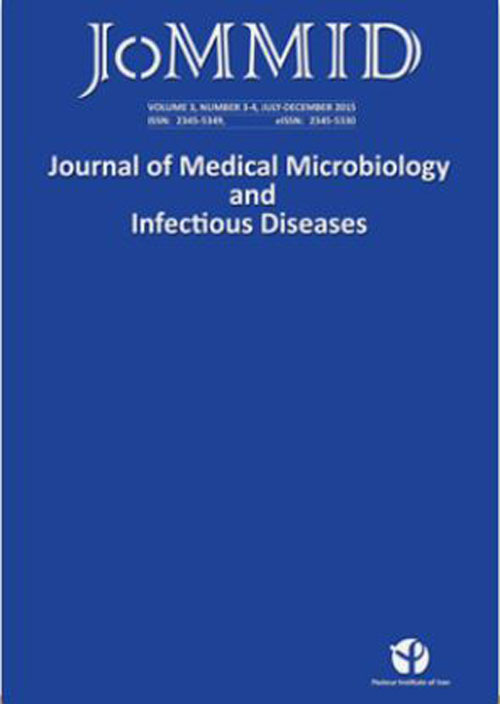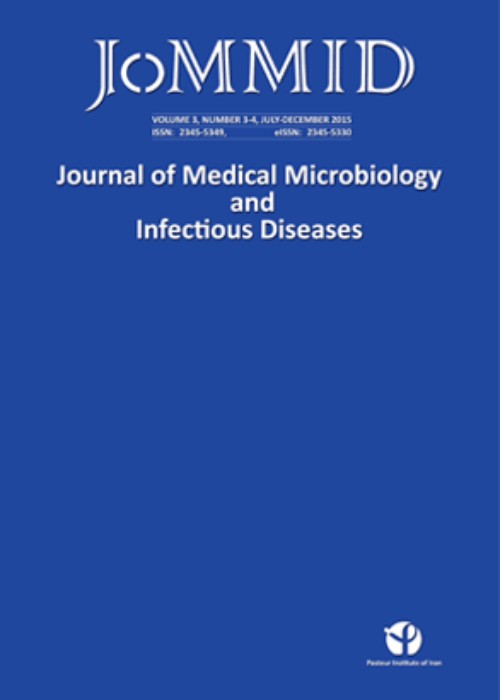فهرست مطالب

Journal of Medical Microbiology and Infectious Diseases
Volume:8 Issue: 4, Autumn 2020
- تاریخ انتشار: 1400/01/10
- تعداد عناوین: 8
-
-
Pages 127-131Introduction
The study aimed to determine the antibacterial activity of ethanolic extract of Matricaria chamomilla (chamomile), Malva sylvestris, and Capsella bursa-pastoris against Methicillin-resistant Staphylococcus aureus (MRSA) isolated from clinical specimens.
MethodsThe plants were collected from Ziarat Village, southern heights of Gorgan, and the required parts were separated and then thoroughly dried in the shade. After grinding, extraction was performed by the maceration method. The extract was dried at 37°C for 24 h. A concentration of 50 mg/ml of each extract was obtained in 10 ml 5% dimethyl sulfoxide and sterilized. For the antibacterial assay, agar well diffusion and broth microdilution methods were used.
ResultsOur results showed no inhibitory effect for the ethanolic extracts of M. sylvestris, and C. bursa-pastoris against the MRSA isolates in both antibacterial assay. The chamomile flower extract showed antibacterial activity against the 20 MRSA isolates at 50 and 25 mg/ml concentrations. The extract from chamomile leaves demonstrated an inhibitory effect on the 7 MRSA isolates. The extracts from chamomile flowers demonstrated MIC and MBC at a concentration of 6.25 and 12.5 mg/ml for most MRSA isolates, while these values for the extracts from chamomile leaves were 12.5 and 25 mg/ml for a few MRSA isolates, respectively.
ConclusionIn this study, the ethanolic flower extract of chamomile showed significant antibacterial activity against the MRSA isolates. Hence, this extract may be an alternative to antibiotic therapy and a good option to control infections caused by MRSA and pathogenic bacteria.
Keywords: Antibacterial activity, Matricaria chamomilla, Malva sylvestris, Capsella bursa-pastoris, Staphylococcus aureus -
Pages 132-136Introduction
Staphylococcus aureus enterotoxin A (SEA) is one of the most common causes of staphylococcal food poisoning. Due to the simplicity and no requirement for laboratory apparatuses, dot-ELISA is a choice method for detecting Staphylococcal enterotoxins. The present study aimed to develop a dot-ELISA for the detection of SEA.
MethodsNitrocellulose membranes were coated with the SEA antibody and blocked by the addition of 3% bovine serum albumin (BSA) blocking buffer. After 1 h incubation and washing the membranes, milk samples and the positive control (SEA, 50 ng/ml) were added to the membranes and incubated for 1 h. The membranes were then washed and incubated for 45 min with HRP-conjugated SEA, followed by the addition of TMB.
ResultsOur dot-ELISA could detect amounts of ≥ 50 ng/ml of SEA in the milk samples. Of the 30 raw milk samples randomly purchased from dairy product stores in District 3, Tehran, 5 (16%) contained SEA ≥ 50 ng/ml by the dot-ELISA.
ConclusionThe dot-ELISA showed to be a reliable method for the preliminary screening of milk samples for SEA contamination. This method is cost-effective, fast, and does not require an ELISA-reader device.
Keywords: dot-ELISA, Staphylococcus aureus Enterotoxin A (SEA), Raw milk -
Pages 137-142Introduction
Hepatitis C virus (HCV) infection and type 2 Diabetes Mellitus (T2DM) are among the severe threats to health care systems worldwide. Here, we investigated the association of HCV genotypes and cirrhosis with T2DM among HCV-positive patients.
MethodsThis descriptive-analytical study was performed from Jan 2017 to Jan 2018 at Sina Clinical-Educational infectious diseases ward, the reference center of infectious diseases in northwest Iran. All serology HCV–positive patients attending this center were included in the study. Forty-eight patients were included, 19 of which had a positive history of diabetes. Blood samples from patients were used for complete blood count, liver function tests, fasting blood sugar, HbA1C, HCV antibodies, and HCV genotype. Then the characteristics among patients with and without T2DM were compared. A P-value of less than 0.05 was considered statistically significant.
ResultsNo significant difference in demographic variables were observed between patients with and without T2DM. Of 48 patients with HCV infection, 29 patients (39.58%) had T2DM. The hepatitis C infection duration among diabetic and non-diabetic patients was 9.03 ± 0.76 years and 8.53 ± 1.01 years, respectively (P = 0.04). Of 8 patients with cirrhosis, six patients (75%) had diabetes. The relative risk for diabetic patients with HCV infection to develop cirrhosis was 4.57 (95% CI [1.02-20.36], P = 0.04). The most prevalent genotype was HCV type 1 among both diabetic and non-diabetic groups. No significant association was observed in logistic regression analysis between the HCV genotypes and T2DM (P = 1.000).
ConclusionIn the current study, we showed that patients with HCV infection are at a higher risk of developing T2DM, and T2DM showed to be a risk factor for the developing cirrhosis among patients with HCV infection.
Keywords: Liver cirrhosis, Diabetes mellitus, Hepacivirus, Hepatitis -
Pages 143-147Introduction
Tracheal tubes are among the primary means of infection transmission in hospitals. Therefore, identifying microbial agents transmitted via this route is necessary to control and prevent these infections. This study aimed to investigate the prevalence of pharyngeal-contaminating microorganisms and their antibiotic resistance pattern.
MethodsIn this cross-sectional study, we used 117 pharyngeal swabs samples obtained from patients referred to Fatemeh Zahra Hospital of Sari, Iran, in 2018. The Samples were obtained using the sterile cotton swab from the throat and then cultured in the sheep blood agar. The positive colonies for the alpha-hemolytic test were subcultured on the Mueller-Hinton agar for further assays, including the susceptibility to optochin, catalase test, Gramchr('39')s polychromatic stain, microscopic examination, pyrrolidonyl aminopeptidase (PYR) test, sensitization to bacitracin, and latex agglutination assay. The antibiotic susceptibility assay was performed using the agar disk diffusion method according to CLSI-2018 guidelines. The results were analyzed using SPSS 16.0 software and descriptive statistical methods.
ResultsThe frequency of Streptococcus pneumoniae and Streptococcus pyogenes was 13.7% and 9.4%, respectively. However, the highest frequency belonged to Pseudomonas aeruginosa (14.5%), and the lowest to Citrobacter spp. (0.9%).
ConclusionOur results indicated increased antibiotic resistance in streptococcal strains due to inappropriate prescriptions and antibiotic misuse. Therefore, recognizing and controlling the contributing factors and the rational use of antibiotics can be very important.
Keywords: Antibiotic Resistance pattern, Tracheal Tube, Streptococcal species -
Pages 148-154Introduction
Plant essential oils can be used as alternative agents for the treatment of antibiotic-resistant pathogenic bacteria. This study aimed to investigate the chemical composition, antibacterial, and antioxidant activity of Thymus eriocalyx and Thymus daenensis essential oils against Gram-positive and Gram-negative human pathogenic bacteria.
MethodsThe aerial part of Thymus eriocalyx and Thymus daenensis in the full flowering stage were collected from West Azerbaijan Province (Urmia), Iran, in 2014. We obtained the essential oils using a Clevenger device. The disc diffusion method was used to determine the antibacterial activity of the essential oils against 15 Gram-positive and Gram-negative PTCC and ATCC bacterial standards. Minimum inhibitory concentrations (MICs) and minimum bactericidal concentrations (MBCs) were measured by microdilution broth method in 96-well plate and free radical scavenging activity by 2,2-diphenyl-1-picrylhydrazyl. Chemical analysis of the essential oils performed out by gas chromatography connected to Mass spectrometry.
ResultsEleven (94.06%) and seven (90.76%) compounds were identified in T. eriocalyx and T. daenensis essential oils, respectively. The major components of T. eriocalyx essential oil were thymol (37.8%) and α-terpineol (14.91%), and of T. daenensis were thymol (52.36%) and carvacrol (16.72%). T. eriocalyx essential oil showed the highest activity against B. cereus with MIC of 0.93 μg mL- and MBC of 1.87 μg mL-. The most potent radical scavenging activity was also obtained for T. daenensis essential oil.
ConclusionEssential oil components of T. eriocalyx and T. daenensis may have the potential to be used as antimicrobial agents against antibiotic-resistant pathogenic bacteria.
Keywords: Essential oil, Antibacterial, Chemical composition, Pathogenic bacteria, Thymus spp -
Pages 155-160Introduction
Immunoglobulin G is the most abundant immunoglobulin in human blood, comprising approximately 75% of serum antibodies. Human IgG is a glycoprotein and can be an antigen for other mammals. Antibody-sensitized red blood cells (RBCs) and complement components can react with anti-human globulins resulting in their agglutination. This study aimed to prepare an antiserum against human IgG for deploying in Coombs Wright and cross-match for rare blood groups.
MethodsAfter isolation of serum from healthy blood donors, serum proteins were precipitated using ammonium sulfate. Consequently, tangential flow filtration and ion-exchange chromatography were applied to purify IgG. SDS-PAGE and Bradford protein content assay was conducted to evaluate the quality and the concentration of the purified IgG. Rabbits were weekly injected with different amounts of the protein four times. Then, sera were obtained from the immunized mice, and total IgG was purified. Finally, the Coombs Wright test was performed on samples from brucellosis patients to validate purified IgG antibody quality.
ResultsElectrophoresis and Bradford assay results showed that the purified protein had considerable high purity and quantity. Protein bands of reducing and the non-reducing SDS-PAGE showed high purity of the protein along with a protein yield of 2.2 mg/L. Coombs Wright tests using the rabbit anti-human serum had a comparable result with available commercial anti-human immunoglobulin.
ConclusionThe results indicated that our method for the purification of IgG was suitable for anti-human globulin preparation. This antibody can also be used in clinical diagnostic tests such as Coombs Wright, cross-match, and blood types evaluation with weak Rh or Du antigens.
Keywords: Anti-human globulin, Immunoglobulins, Coombs Wright -
Pages 161-165Introduction
The data on members of the genera Proteus, Pseudomonas, Enterobacter, Citrobacter, and Staphylococcus as the etiologic agents of urinary tract infections (UTIs) is not much. This study investigated the frequency of various beta-lactamases in urine isolates of Proteus mirabilis, Enterobacter cloacae, and Citrobacter freundii in Gorgan, Golestan province.
MethodsA total of 632 urine samples were collected from hospitalized patients in a teaching hospital. The samples were cultured on blood agar and Eosin Methylene blue agar and incubated overnight at 37°C. The cultures with a ≥105 CFU/mL bacterial count were defined as positive for UTI. Bacteria identification was performed using standard biochemical methods and the API20E enteric identification system. The antibiotic resistance pattern was determined by the Kirby-Bauer disk diffusion method, and a phenotypic confirmatory test was used for detecting ESBL, MBL, and AmpC beta-lactamases producers.
ResultsOut of 632 samples, 317 (50.1%) were positive for UTIs, and 27 (8.5%), 21 (6.6%), and 12 (3.7%) were positive for Enterobacter cloacae, Citrobacter freundii, and Proteus mirabilis isolates, respectively. All the isolates were sensitive to piperacillin-tazobactam and colistin. The prevalence of ESBL and AmpC beta-lactamases in P. mirabilis isolates was higher than the other isolates, but No MBL producers were detected.
ConclusionsIn this study, the high frequency of ESBL and AmpC beta-lactamases in P. mirabilis isolates may suggest an increasing trend in resistance to cephalosporins and monobactams, which could have a significant impact on the management and treatment of UTI caused by this organism. Therefore, continuous monitoring is required to control the spread of β-lactamase-producing isolates in different geographical areas.
Keywords: Beta-lactamases, Proteus mirabilis, Enterobacter cloacae, Citrobacter freundii, Prevalence -
Pages 166-171Introduction
Successful development of free-living stages of parasitic helminths depends on larva ability to survive, develop, and hatch. In this study, we aimed to study the host role in the hatching process of Fasciola species.
MethodsFasciola hepatica and Fasciola gigantica eggs were collected from adult worms that originated from naturally infected sheep and cattle livers and were incubated at 26±1°C for 15 days. The percentage of hatched and developed eggs were obtained for each isolate under a light microscope. A polymerase chain reaction followed by restriction fragment length polymorphism (PCR-RFLP) was applied to identify the F. hepatica and F. gigantica species.
ResultsOur findings showed no significant differences in the development rates of F. gigantica and F. hepatica eggs in sheep (69.32% and 72.71%) and cattle (73.56% and74.69%). However, the rates of hatched eggs of F. gigantica and F. hepatica originated from cattle (69.19% and 62.36%) were almost twice the rates in sheep (31.69% and 32.59%), indicating a significant difference.
ConclusionThis study demonstrated that host species significantly affect the hatching of Fasciola eggs as the hatching rates of F. gigantica and F. hepatica originated from cattle were higher than those taken from sheep did not affect their larval development. Thus, in addition to environmental factors, the hatching phenomenon is influenced by host species.
Keywords: Egg, Fasciola, Hatch, cattle, sheep


